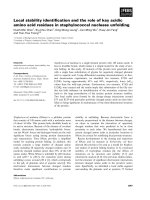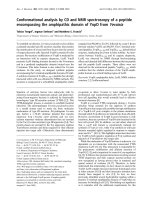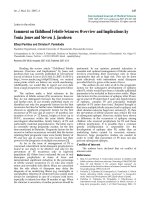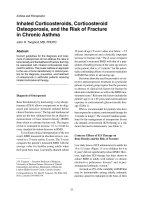Báo cáo y học: "Commentary on “Genetic linkage and transmission disequilibrium of marker haplotypes at chromosome 1q41 in human systemic lupus erythematosus”, by RR Graham et al" pdf
Bạn đang xem bản rút gọn của tài liệu. Xem và tải ngay bản đầy đủ của tài liệu tại đây (33.41 KB, 3 trang )
bp = base pairs; SLE = systemic lupus erythematosus; TDT = transmission disequilibrium test.
Available online />Introduction
Because linkage analysis approaches had been success-
ful in the identification of disorders inherited as Mendelian
traits, it was expected that the genetic basis of common
diseases would be identified using a similar approach, but
results to date may seem disappointing. As for most
common diseases, susceptibility to autoimmunity is
thought to be determined by both genetic and environ-
mental factors. These autoimmune diseases tend not to be
inherited in simple Mendelian fashion, but exhibit complex
patterns of segregation. Investigation of these diseases
can often be hampered by factors such as late age at
disease onset, variable penetrance, variable phenotypic
expression (different combinations of genes may predis-
pose to different patterns of disease), unknown gene–
gene and gene–environment interactions, genetic hetero-
geneity (different genes may produce the same pheno-
type), and misclassification of clinical phenotypes. Hence,
the task of identifying susceptibility genes for complex dis-
orders is enormous.
Investigation of genetic susceptibility loci for
systemic lupus erythematosus
Twin and family studies suggest that systemic lupus ery-
thematosus (SLE) has a substantial genetic susceptibility
component [1–3]. Whole-genome scans of SLE families
with affected sibling pairs have now been published, and,
despite the relatively small sizes of the individual studies
and the ethnic heterogeneity of the populations studied,
there appears to be a surprising degree of overlap
between findings [4–8]. All the studies have reported
linkage to regions of the long arm of chromosome 1. In
volume 3 issue 5 of this journal, Graham et al. described
their approach to following up this linkage data for one of
these regions, mapping to 1q41–42 [9].
Linkage analysis identifies genomic regions that are
shared, identical-by-descent, by siblings affected by
disease more often than would be expected by chance
alone. However, linkage typically extends for 10 cM or
more and such a region could contain 500 genes. Varia-
Commentary
Commentary on “Genetic linkage and transmission
disequilibrium of marker haplotypes at chromosome 1q41 in
human systemic lupus erythematosus”, by RR Graham
et al.
Anne C Barton and Jane Worthington
Arthritis and Rheumatism Campaign Epidemiology Unit, University of Manchester, Manchester, UK
Correspondence: Anne C Barton, ARC-EU, Stopford Building, University of Manchester M13 9PT, UK. Tel: +44 161 275 5037;
fax: +44 161 275 5043; e-mail:
Abstract
Genome-wide linkage analysis studies in families with systemic lupus erythematosus (SLE) have
revealed consistent evidence of linkage to several regions of the genome. In a previous issue of this
journal, Graham and colleagues described their approach to following up the linkage data for one of
these regions, 1q41–42. Using methods based on the transmission disequilibrium test, the region
likely to harbour a SLE disease gene was refined to 2.3 Mb. This commentary discusses their
approach and identifies lessons that may be applicable to the investigation of other complex diseases.
Keywords: association, linkage, systemic lupus erythematosus, transmission disequilibrium test, whole-genome scan
Received: 14 August 2001
Revisions requested: 18 October 2001
Revisions received: 30 October 2001
Accepted: 5 November 2001
Published: 19 November 2001
Arthritis Res 2002, 4:84-86
This article may contain supplementary data which can only be found
online at />© 2002 BioMed Central Ltd
(
Print ISSN 1465-9905; Online ISSN 1465-9913)
Available online />tion in any one of these genes could be responsible for
the observed linkage. Association is the nonrandom
cosegregation of alleles and assumes that populations are
descended from a small founder group and that repeated
recombinations over generations reduce the shared chro-
mosomal segments to very small regions. Therefore, in
order to detect an association, the marker and disease
gene must be in linkage disequilibrium [10]. Because
linkage disequilibrium extends for shorter distances
(~60 Kbp from common coding variants in the North
American population) [11], demonstration of association
refines the region likely to harbour the disease gene.
Linkage disequilibrium mapping can be carried out either
by directly testing potential candidate genes or by using
microsatellite markers mapping to a region of linkage.
Going directly to candidate genes is fraught with danger.
Virtually any gene could be a candidate, and sometimes
functional genes appear to have an obscure role, e.g.
APOE gene polymorphism and Alzheimer’s disease [12].
The alternative approach taken by Graham et al. was to try
to refine the ~16 cM region of linkage likely to harbour the
disease gene by first investigating association with a
number of microsatellite markers mapping to the region in
210 families with affected sibling pairs and 122 families
with three affected members. Using extensions of the
family-based association method, the transmission dis-
equilibrium test (TDT) [13], they found strong evidence for
association with one marker, D1S490, by all the TDT
methods used. Haplotype analysis not only can increase
the power to detect association but also can be used to
localise the genetic region harbouring the disease gene.
Association with three haplotypes spanning ~9 cM was
demonstrated using two-marker approaches. When three-
marker haplotypes were investigated, however, associa-
tion with two different combinations of markers, spanning
just 3 cM, was demonstrated. The equivalent physical dis-
tance is ~2.3 Mb. Reassuringly, linkage to the 1q41–42
region was largely accounted for by families carrying
either of two risk haplotypes spanning the five markers.
Even though the results presented in the study provide
consistent and compelling evidence to support associa-
tion to the region using a number of tests, it must be
remembered that no correction has been applied for multi-
ple testing, and confirmation of these findings in other
data sets is required.
Lessons that can be drawn from this study
The study teaches us several important lessons. Firstly, it
demonstrates the usefulness of animal models of disease
in implicating candidate susceptibility regions in humans.
The 1q41–42 region is homologous to a locus linked to a
mouse model of lupus, and linkage in humans was first
demonstrated after this area was targeted as a candidate
susceptibility region using information from the mouse
model [14]. Secondly, it is salutary to note that the linkage
results for this region from analysis of whole-genome
scans might have been discounted if stringent criteria had
been applied [15]. In both whole-genome scans reporting
linkage to the region, the LOD scores (logarithms of odds
ratios) barely achieved statistically significant evidence for
linkage [4–7]. However, replication of findings by indepen-
dent groups is strong evidence that the findings are not
due to a type-1 error. Identification of association with
specific haplotypes of markers and demonstration that
families with these haplotypes are largely responsible for
the evidence of linkage support the hypothesis that true
susceptibility genes may map to the region. Thirdly, this
study demonstrates the superior ability of haplotype analy-
sis to detect association over single-point methods. The
gain in power from haplotyping arises in two main ways:
analysis of single markers for tests of association using
TDT-based methods can only use information from families
in which transmissions are informative, i.e. when either the
known or the inferred parental genotype is heterozygous at
the locus under investigation. Haplotype methods can be
more powerful, because transmission of a combination of
markers is assessed, so that even if the inferred parental
genotype is homozygous at one locus, it may not be at a
second, third, or subsequent locus. The increase in power
provided by haplotype methods also arises because there
may be preferential allele transmission at two loci which,
when analysed separately, do not achieve statistical signifi-
cance, whereas a haplotype of alleles from the combination
of markers may be strongly associated with disease.
Conclusion
Thus, from a linkage result that implicated an ~16 cM
region, Graham et al. have refined the region likely to
harbour an SLE disease gene to a manageable 2.3 Mb. A
region this size is still likely to contain many candidate
genes, so the task of identifying which is the disease gene
is still huge. Demonstration of association with polymor-
phisms mapping to potentially functional domains of a
gene may implicate it as the disease gene, but association
does not necessarily imply causation (the association
could arise due to linkage disequilibrium with a disease
mutation in a nearby gene) and confirmation will require
functional studies. Alternatively, the animal model in which
the homologous region was first implicated may help in
the identification of the disease gene.
Acknowledgements
Dr A Barton is in receipt of an MRC Clinical Research Fellowship. Dr J
Worthington is funded by the Arthritis and Rheumatism Campaign.
References
1. Block SR, Winfield JB, Lockshin MD, D’Angelo WA, Christian CL:
Studies of twins with systemic lupus erythematosus: A review
of the literature and presentation of 12 additional sets. Am J
Med 1975, 59:533-552.
2. Deapen D, Escalante A, Weinrib L, Horwitz D, Bachman B, Roy-
Burman P, Walke A, Mack TM: A revised estimate of twin con-
cordance in systemic lupus erythematosus. Arthritis Rheum
1992, 35:311-318.
Arthritis Research Vol 4 No 2 Barton and Worthington
3. Vyse TJ, Todd JA: Genetic analysis of autoimmune disease.
Cell 1996, 85:311-318.
4. Gaffney PM, Ortmann WA, Selby SA, Shark KB, Ockenden TC,
Rohlf KE, Walgrave NL, Boym WP, Malmgren ML, Miller ME,
Kearns GM, Messner RP, King RA, Rich SS, Behrens TW:
Genome screening in human systemic lupus erythematosus:
results from a second Minnesota cohort and combined analy-
ses of 187 sib-pair families. Am J Hum Genet 2000, 66:547-
556.
5. Gaffney PM, Kearns GM, Shark KB, Ortmann WA, Selby SA,
Malmgren ML, Rohlf KE, Ockenden TC, Messner RP, King RA,
Rich SS, Behrens TW: A genome-wide search for susceptibil-
ity genes in human systemic lupus erythematosus sib-pair
families. Proc Natl Acad Sci U S A 1998, 95:14875-14879.
6. Gray-McGuire C, Moser KL, Gaffney PM, Kelly J, Yu H, Olson JM,
Jedrey CM, Jacobs KB, Kimberly RP, Neas BR, Rich SS, Behrens
TW, Harley JB: Genome scan of human systemic lupus erythe-
matosus by regression modelling. Evidence of linkage and
epistasis at 4p16-15.2. Am J Hum Genet 2000, 67:1460-1469.
7. Moser KL, Neas BR, Salmon JE, Yu H, Gray-McGuire C, Asundi
N, Bruner GR, Fox J, Kelly J, Henshall S, Bacino D, Dietz M,
Hogue R, Koelsch G, Nightingale L, Shaver T, Abdou NI, Albert
DA, Carson C, Petri M, Treadwell EL, James JA, Harley JB:
Genome scan of human systemic lupus erythematosus: evi-
dence for linkage to chromosome 1q in African-American
pedigrees. Proc Natl Acad Sci U S A 1998, 95:14869-14874.
8. Shai R, Quismorio FP Jr, Li L, Kwon OJ, Morrison J, Wallace DJ,
Neuwelt CM, Brautbar C, Gauderman WJ, Jacob CO: Genome-
wide scan for systemic lupus erythematosus susceptibility
genes in multiples families. Hum Mol Genet 1999, 8:639-644.
9. Graham RR, Langefeld CD, Gaffney PM, Ortmann WA, Selby SA,
Baechler EC, Shark KB, Ockenden TC, Rohlf KE, Moser KL,
Brown WM, Gabriel SE, Messner RP, King RA, Horak P, Elder JT,
Stuart PE, Rich SS, Behrens TW: Genetic linkage and trans-
mission disequilibrium of marker haplotypes at chromosome
1q41 in human systemic lupus erythematosus. Arthritis Res
2001, 3:299-305.
10. Jorde LB: Linkage disequilibrium as a gene mapping tool. Am
J Hum Genet 1995, 56:11-14.
11. Reich DE, Cargill M, Bolk S, Ireland J, Sabeti PC, Richter DJ,
Lavery T, Kouyoumjian R, Farhadian SF, Ward R, Lander ES:
Linkage disequilibrium in the human genome. Nat Genet
2001, 411:199-204.
12. Corder EH, Saunders AM, Risch NJ, Strittmatter WJ, Schmechel
DE, Gaskell PC, Small GW, Roses AD, Haines JL, Pericak-Vamce
MA: Gene dosage of apolipoprotein E type 4 allele and the
risk of Alzheimer’s disease in late onset families. Science
1993, 261:921-923.
13. Speilman RS, McGinnis RE, Ewens WJ: Transmission disequi-
librium test for linkage disequilibrium: the insulin gene region
and insulin dependent diabetes mellitus (IDDM). Am J Hum
Genet 1993, 52:506-516.
14. Tsao BP, Cantor RM, Kalunian KC, Chen CJ, Badsha H, Singh R,
Wallace DJ, Kitridou RC, Chen SL, Shen N, Song YW, Isenberg
DA, Yu CL, Hahn BH, Rotter JI: Evidence for linkage of a candi-
date chromosome 1 region to human systemic lupus erythe-
matosus. J Clin Invest 1997, 99:725-31.
15. Lander ES, Kruglyak L: Genetic dissection of complex traits:
guidelines for interpreting and reporting linkage results. Nat
Genet 1995, 11:241-247.









